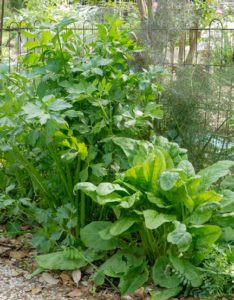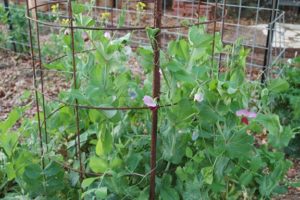Hooray for Rain!

‘Kintsai’ Chinese celery, sorrel and bronze fennel appreciate cool weather.
We’ve had a nice little patch of rain here at the end of August and start of September. My fall planted vegetables have certainly perked up and seeds are sprouting better. But so are the weeds!
In typical Austin fashion, September brings rain but we still have those super-hot days. It makes me laugh when I’m outside and I get soaked from rain and sweat at the same time.
September Vegetable Garden Checklist
Here is the vegetable gardener’s checklist for September:
Fertilizer
- Use only mild liquid fertilizers this month while it’s still hot, and only if your soil test indicates it.
Water and Irrigation
- Even though we might get a little rain, monitor the moisture in your garden. You may still have to irrigate regularly, especially if you are setting out new transplants or planting seeds. In hot weather for my garden, I like to water newly planted seeds every day until they sprout and then every other day until they get several sets of leaves, then taper off depending on the weather and type of plant back to once a week. For transplants, I’ll water every day for the first three days, then every other day until I see new leaves growing, then taper off depending on the weather and type of plant back to once a week. Keep in mind that I am on heavy clay soil. Things may be different in your garden.
Planting
- Set out transplants of broccoli, cauliflower, cabbage and Brussels sprouts; gradually expose plants to sunny outdoor conditions before planting in the garden. Though you might be successful planting quick maturing broccoli and cabbage varieties from seed, using transplants means an earlier harvest.
- Try some fast-growing and nutritious Asian greens this fall. There are many varieties of pak choi, tatsoi, Chinese cabbage and mustards available from online sources such as https://kitazawaseed.com/ and https://www.johnnyseeds.com/.
- Plant some green onions. Also known as scallions, these delicately flavored onions do not form a bulb but rather a single, tubular stem. Plant several seeds and harvest as needed, adding thin slices to casseroles, pasta, soups, dips, salsa and stir-fry dishes. The slender green stems are a concentrated source of phytonutrients so be sure to eat the whole thing. Better yet, consider a perennial planting of Multiplier onions. These have the same slender profile as green onions but pack a bit more heat in the white part.

A tomato cage supports the 3 foot vines and purple blooms of ‘Dwarf Grey Sugar’ snow peas.
- Try cutting celery for the kitchen. Also known as Chinese celery, its thin stalks and jagged leaves are more pungent than celery and easier to grow. Using just a small amount of leaves or thinly sliced stems will add flavor to stews, soups, stocks and stir-fries. You can order seeds from https://www.johnnyseeds.com/ (look for “cutting celery) or www.kitazawaseed.com but some local nurseries will carry transplants among the herbs.
- There is still time to plant cucumbers, summer squash and bush beans. Look for varieties that produce in less than 60 days and plant seed early in the month.
- Plant beets, radishes, turnips and carrots into moist soil (just after a soaking rain is ideal) and cover lightly with floating row cover or a shallow layer of compost to preserve moisture and aid in germination. Once seeds have sprouted, thin to the proper spacing.
- Swiss chard, collards, kale and kohlrabi can be seeded directly in the garden or can go in as transplants.
- Plant snow peas and sugar snap peas this month; keep soil evenly moist until seeds have germinated.
- Grow some herbs! Fall is prime-time for cool season herbs including cilantro, dill, thyme, parsley, sage, chives and oregano. Plant late in the month, giving them full sun and well-drained soil. Shade tolerant herbs include chervil, parsley, mint, sorrel and salad burnet.
Maintenance
- Keep beds well-mulched throughout the season to conserve moisture and moderate soil temperature.
Additional Resources
Watch the Vegetable Gardening in Central Texas Webinar
Vegetable Planting Calendar (English) (Español) (繁体中文)
Recommended Vegetable Varieties for Travis County
Plant Rotations, Successions and Intercropping
Monthly Gardening Calendar for Austin and Central Texas
About Sheryl Williams
 Sheryl Williams has been a Travis County Master Gardener since 2010 and currently works as the Horticulture Program Assistant at Texas A&M AgriLife Extension – Travis County. She was introduced to gardening by her mom and grandma and has been an avid vegetable gardener most of her life. Sheryl believes that there is nothing more satisfying than growing and preparing your own food. She likes gardening in Austin year round and concedes that means pulling weeds every day. She practices organic gardening principles and enjoys the challenge of outsmarting garden pests. Occasionally she loses these battles, but doesn’t mind sharing a good meal.
Sheryl Williams has been a Travis County Master Gardener since 2010 and currently works as the Horticulture Program Assistant at Texas A&M AgriLife Extension – Travis County. She was introduced to gardening by her mom and grandma and has been an avid vegetable gardener most of her life. Sheryl believes that there is nothing more satisfying than growing and preparing your own food. She likes gardening in Austin year round and concedes that means pulling weeds every day. She practices organic gardening principles and enjoys the challenge of outsmarting garden pests. Occasionally she loses these battles, but doesn’t mind sharing a good meal.

